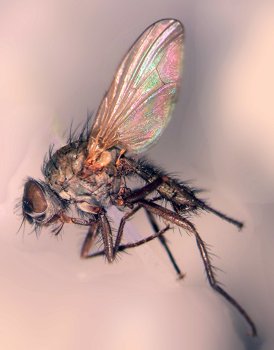Pests
Delia antiqua (Meigen) - Onion Fly.
Systematic position.
Class Insecta, order Diptera, family Anthomyiidae, genus Delia.Synonyms.
Hylemya antiqua (Meigen) (=Chortophila, Phorbia).Biological group.
Oligophagous pest of onion.Morphology and biology.
Body reaches 5-7 mm, ash-gray; mesonotum with greenish shimmer. Legs black, antennal arista pubescent. Male abdomen with more or less clearly expressed dark longitudinal stripe. Female abdomen without such stripe. Wings transparent. Female lays eggs in series or in groups (of 5 to 20) on onion shoots, leaves, bulbs, and on ground near plants for 12-30 days, up to 200 eggs. Eggs white, elongated. Larvae hatch in 3-8 days. Larva reach 10 mm long, white, cylindrical. Hind apex of abdomen oblique; anal plate having two red plates in the middle, each with 3 spiracular slits. Around the anal plate 16 conic tubercles are located, of which 4 median ones are larger than the rest. Hatching larvae go into bulb pulp from the root side or through the base of leaves. Larvae hatching from one egg-batch usually keep together and eat away rather big cavities in bulbs. Sometimes more than 50 larvae feed on one bulb, originating from eggs laid by different females. Larvae feed for 15-25 days, molting three times. Larval development proceeds in one bulb in large onions and in several bulbs in seeding-onions. Pupation occurs in the ground at depths of 10-20 cm; the pupal phase of spring generation lasts 2-3 weeks.Distribution.
Cosmopolitan. A pest in Northern America, Western Europe, China, Japan, Korea. In the former USSR it is found everywhere, north to forest-tundra inclusive. In Central Asia it rises up to 3600 m above sea level, absent in deserts.Ecology.
Monovoltine in regions of the Far North (Murmansk, Igarka); 2 generations in Ukraine, 3 in southern areas under favorable conditions, to 4 generations in southern Kazakhstan. In nature the species is a phytophage, living on wild onions and other plants of the families Liliaceae and Iridaceae. It causes harm to cultivated onions more intensively on sandy and loamy soils than on peat soil. The flight of imagoes of spring generation occurs in April - May during cherry and dandelion flowering. Flies of the second generation appear at the end of June and the beginning of July. Females need additional feeding on nectar of flowers for egg laying. Optimum conditions for egg development are temperatures of 17-22°C and humidity levels at 75-80 %. The lowered temperatures stimulate some of spring generation pupae to enter winter diapause.Economic significance.
The pest larvae damage garden bulb onions, and also garlic, chive, underground onion (shallot), leek, bulbs of tulips. First generation of the fly is the most harmful because the development of larvae coincides with the beginning of onion growth. Damage of the Onion Fly is lower in humid and cold springs, as the imagoes occur later and the period of larvae hatching is extended. Leaves start to turn yellow in damaged plants, and bulbs rot quickly, especially quickly in humid weather. Control measures include maintenance of crop rotation, early sowing or landing of onions, periodic survey and removal of infested plants, pre-sowing seed dressing, and autumn digging of ground for destruction of the pest pupae.Related references:
Bogacheva V.I. 1964. Dipteran onion pests and their control in Middle Ural. In: Kalashnikov A.P., ed. Proceedings of Ural Institute of Agriculture. Sverdlovsk: UrNIISKh, v. 5: 279-295. (In Russian)Dzholova N.G. 1965. Insect pests of vegetable crops in Baikal region. Moscow: Nauka, 80 pp. (In Russian)
El.berg K.Yu. 1981. Antomyiidae. In: Narchuk E.P. & Tryapitsyn V.A., eds. Insects and mites - pests of agricultural plants. V. 4. Hymenoptera and Diptera. Leningrad: Nauka: 188-198. (In Russian)
Kalandadze L.P., Shavkatsishvili L.D. 1960. Materials on Delia antiqua Meig. in Georgia. In: Proceedings of Institute of Plant Protection, Tbilisi: GruzASKhN, v. 13: 147-166. (In Russian)
Rogochaya E.G. 1974. Antomyiidae. In: Vasil.ev V.P., ed. Pests of agricultural crops and forest plantations. Kiev: Urozhai, v.2: 540-548. (In Russian)
Turaev I.S., Sokolova A.G. 1975. Onion Fly in Middle Ural. In: Turaev I.S., ed. Biological and technological bases of agricultural crops yield growth. Proceedings of Sverdlovsk Institute of Agriculture. Perm: Perm SKhI, v. 35: 99-113. (In Russian)


